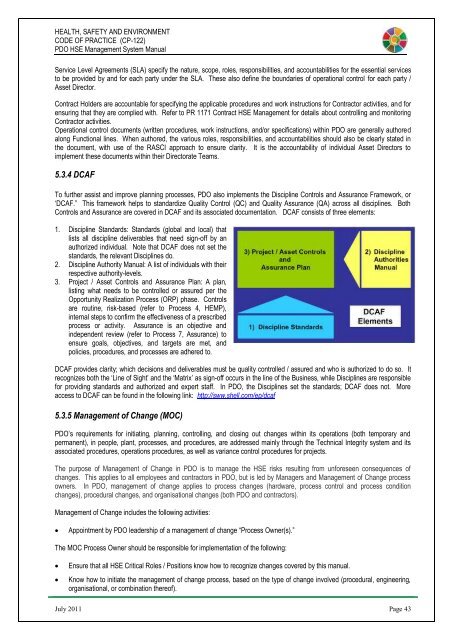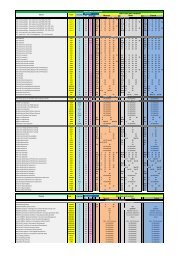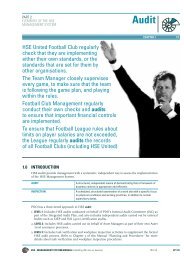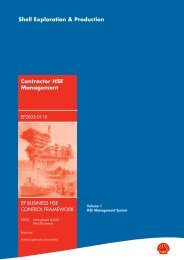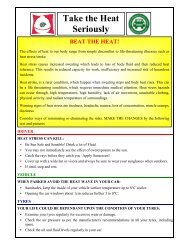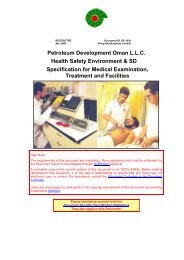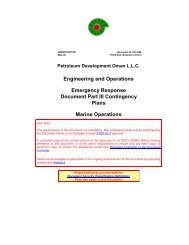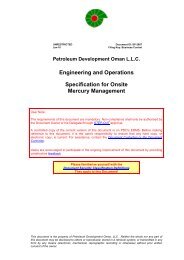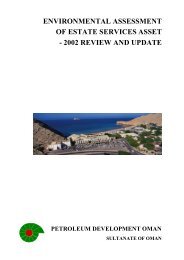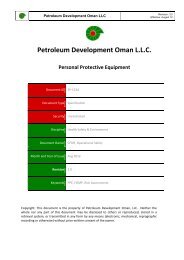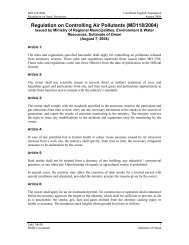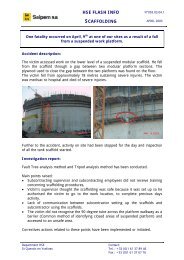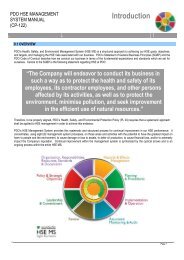CP-122 HSE Code of Practice - PDO
CP-122 HSE Code of Practice - PDO
CP-122 HSE Code of Practice - PDO
Create successful ePaper yourself
Turn your PDF publications into a flip-book with our unique Google optimized e-Paper software.
HEALTH, SAFETY AND ENVIRONMENT<br />
CODE OF PRACTICE (<strong>CP</strong>-<strong>122</strong>)<br />
<strong>PDO</strong> <strong>HSE</strong> Management System Manual<br />
Service Level Agreements (SLA) specify the nature, scope, roles, responsibilities, and accountabilities for the essential services<br />
to be provided by and for each party under the SLA. These also define the boundaries <strong>of</strong> operational control for each party /<br />
Asset Director.<br />
Contract Holders are accountable for specifying the applicable procedures and work instructions for Contractor activities, and for<br />
ensuring that they are complied with. Refer to PR 1171 Contract <strong>HSE</strong> Management for details about controlling and monitoring<br />
Contractor activities.<br />
Operational control documents (written procedures, work instructions, and/or specifications) within <strong>PDO</strong> are generally authored<br />
along Functional lines. When authored, the various roles, responsibilities, and accountabilities should also be clearly stated in<br />
the document, with use <strong>of</strong> the RASCI approach to ensure clarity. It is the accountability <strong>of</strong> individual Asset Directors to<br />
implement these documents within their Directorate Teams.<br />
5.3.4 DCAF<br />
To further assist and improve planning processes, <strong>PDO</strong> also implements the Discipline Controls and Assurance Framework, or<br />
„DCAF.” This framework helps to standardize Quality Control (QC) and Quality Assurance (QA) across all disciplines. Both<br />
Controls and Assurance are covered in DCAF and its associated documentation. DCAF consists <strong>of</strong> three elements:<br />
1. Discipline Standards: Standards (global and local) that<br />
lists all discipline deliverables that need sign-<strong>of</strong>f by an<br />
authorized individual. Note that DCAF does not set the<br />
standards, the relevant Disciplines do.<br />
2. Discipline Authority Manual: A list <strong>of</strong> individuals with their<br />
respective authority-levels.<br />
3. Project / Asset Controls and Assurance Plan: A plan,<br />
listing what needs to be controlled or assured per the<br />
Opportunity Realization Process (ORP) phase. Controls<br />
are routine, risk-based (refer to Process 4, HEMP),<br />
internal steps to confirm the effectiveness <strong>of</strong> a prescribed<br />
process or activity. Assurance is an objective and<br />
independent review (refer to Process 7, Assurance) to<br />
ensure goals, objectives, and targets are met, and<br />
policies, procedures, and processes are adhered to.<br />
DCAF provides clarity; which decisions and deliverables must be quality controlled / assured and who is authorized to do so. It<br />
recognizes both the „Line <strong>of</strong> Sight‟ and the „Matrix‟ as sign-<strong>of</strong>f occurs in the line <strong>of</strong> the Business, while Disciplines are responsible<br />
for providing standards and authorized and expert staff. In <strong>PDO</strong>, the Disciplines set the standards; DCAF does not. More<br />
access to DCAF can be found in the following link: http://sww.shell.com/ep/dcaf<br />
5.3.5 Management <strong>of</strong> Change (MOC)<br />
<strong>PDO</strong>‟s requirements for initiating, planning, controlling, and closing out changes within its operations (both temporary and<br />
permanent), in people, plant, processes, and procedures, are addressed mainly through the Technical Integrity system and its<br />
associated procedures, operations procedures, as well as variance control procedures for projects.<br />
The purpose <strong>of</strong> Management <strong>of</strong> Change in <strong>PDO</strong> is to manage the <strong>HSE</strong> risks resulting from unforeseen consequences <strong>of</strong><br />
changes. This applies to all employees and contractors in <strong>PDO</strong>, but is led by Managers and Management <strong>of</strong> Change process<br />
owners. In <strong>PDO</strong>, management <strong>of</strong> change applies to process changes (hardware, process control and process condition<br />
changes), procedural changes, and organisational changes (both <strong>PDO</strong> and contractors).<br />
Management <strong>of</strong> Change includes the following activities:<br />
<br />
Appointment by <strong>PDO</strong> leadership <strong>of</strong> a management <strong>of</strong> change “Process Owner(s).”<br />
The MOC Process Owner should be responsible for implementation <strong>of</strong> the following:<br />
<br />
<br />
Ensure that all <strong>HSE</strong> Critical Roles / Positions know how to recognize changes covered by this manual.<br />
Know how to initiate the management <strong>of</strong> change process, based on the type <strong>of</strong> change involved (procedural, engineering,<br />
organisational, or combination there<strong>of</strong>).<br />
July 2011 Page 43


